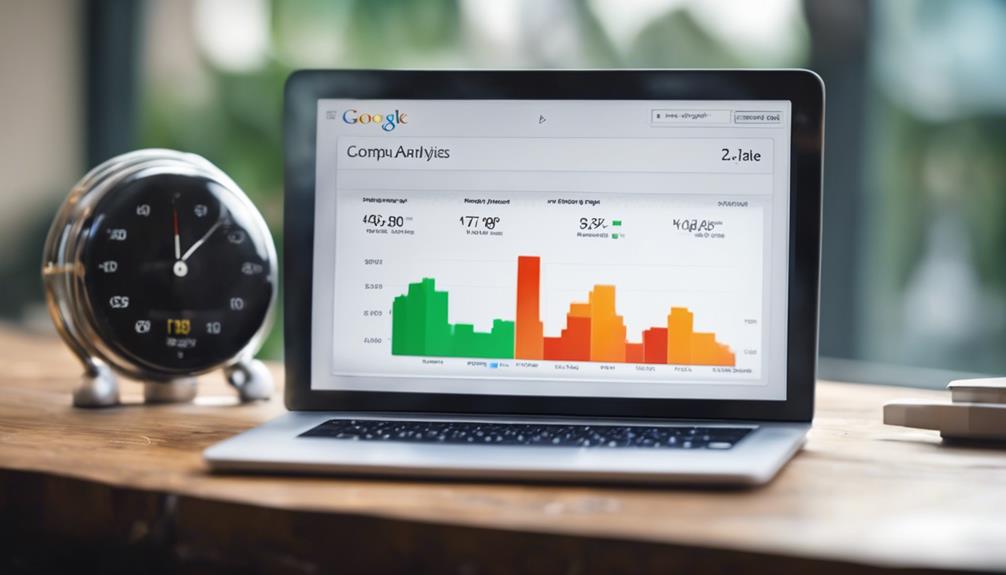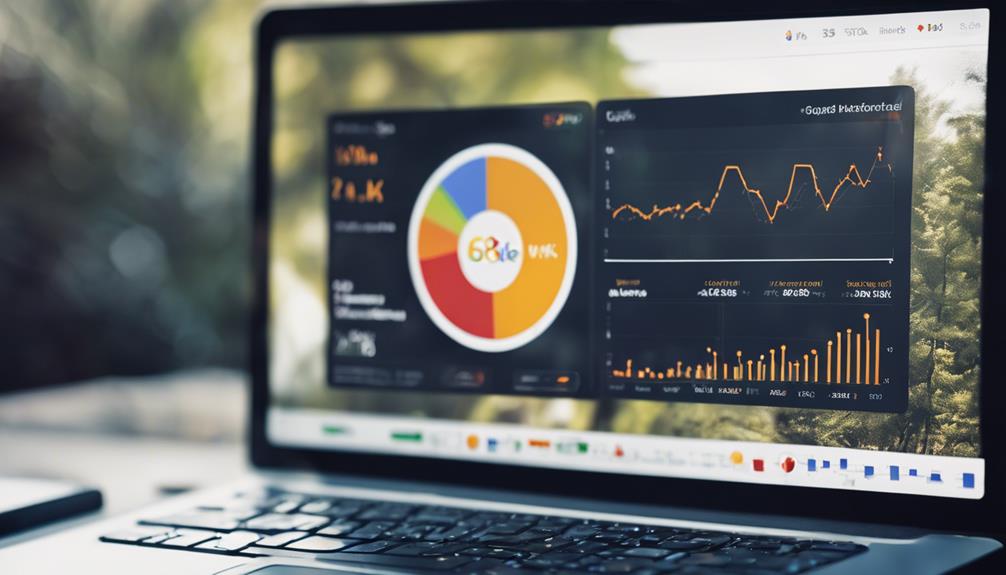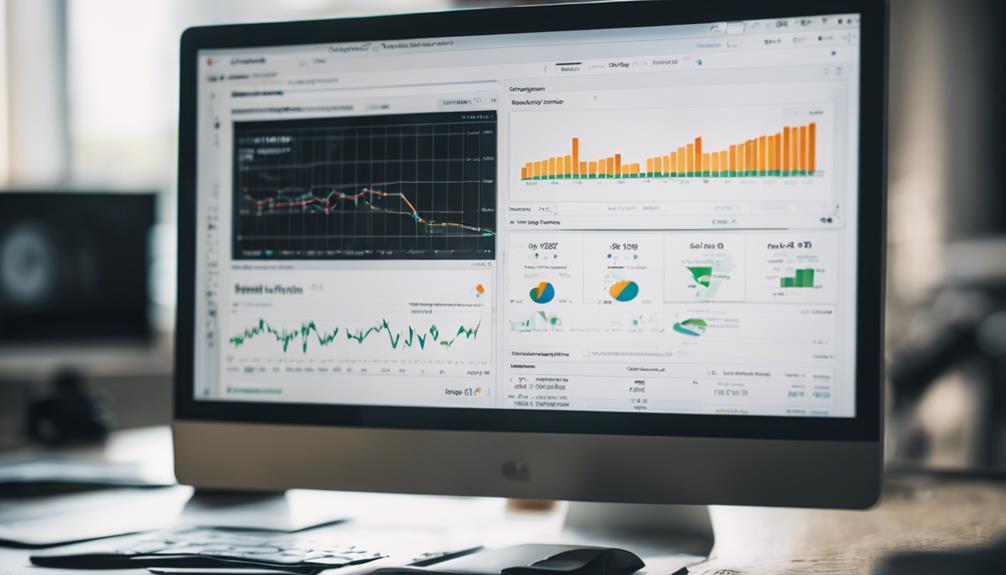When it comes to tracking online performance, Google Analytics serves as a powerful tool that provides a wealth of insights into your website's activity and user interactions. By analyzing data on website traffic, user demographics, and engagement metrics, Google Analytics enables you to make data-driven decisions to enhance your online presence.
But how exactly does this platform help you uncover valuable information that can shape your digital strategy and drive success? Let's delve into the key roles Google Analytics plays in tracking and optimizing online performance.
Key Takeaways
- Google Analytics provides valuable insights into website traffic and user behavior for tracking online performance.
- User behavior analysis helps optimize content, marketing strategies, and overall website performance.
- Website interaction tracking enhances user experience by tailoring content and improving site navigation.
- Leveraging Google Analytics metrics enables data-driven decisions for continuous improvement in online performance.
Importance of Tracking Online Performance
Tracking online performance with Google Analytics is essential for businesses seeking to optimize their digital strategies effectively. By utilizing this powerful tool, you can gain valuable insights into website traffic, user behavior, and engagement metrics. Google Analytics enables you to evaluate the performance of your online strategies, including SEO, content marketing, and advertising campaigns, allowing you to make data-driven decisions for enhancement.
Monitoring key indicators such as bounce rate, conversion rates, session duration, and goal completions through Google Analytics provides a comprehensive view of your online success and areas needing improvement. Additionally, tracking traffic sources, audience demographics, and device usage offers critical information to understand user preferences and tailor your online efforts accordingly.
With Google Analytics, you have the opportunity to analyze data meticulously, boost website performance, and drive growth through informed decision-making. Embracing the insights provided by Google Analytics empowers you to refine your online strategies effectively and stay ahead in the digital landscape.
User Behavior Analysis With Google Analytics
When analyzing user behavior with Google Analytics, you can gain valuable insights into how visitors interact with your website. By tracking metrics like bounce rates and session duration, you can identify patterns that indicate user engagement levels.
Understanding these behavior patterns allows you to optimize your website content and marketing strategies for improved performance.
Behavior Patterns Analysis
By analyzing behavior patterns with Google Analytics, valuable insights can be gained into how users engage with website content, aiding in optimizing user experience and enhancing overall performance.
Understanding user behavior, such as popular pages, high-exit pages, and user flow through the website, is crucial for refining marketing strategies, improving content relevance, and increasing conversions.
Google Analytics' behavior patterns analysis helps in making data-driven decisions to enhance website performance and achieve business goals. By leveraging these insights, you can tailor your website to meet user expectations, ultimately driving better engagement and conversions.
This detailed analysis allows you to fine-tune your online presence, ensuring that every aspect of your website is aligned with user preferences and behaviors.
Website Interaction Tracking
To gain a comprehensive understanding of user behavior on websites, Google Analytics analyzes various metrics such as page views, bounce rates, and session duration. This website interaction tracking is crucial for user behavior analysis and optimizing website performance.
By examining visitor flow and conversion paths, businesses can enhance their website's effectiveness. Google Analytics enables the tracking of how users navigate through the site, identifying popular pages and areas for improvement.
Understanding user behavior through metrics like session duration helps in tailoring content and design to meet user preferences. Utilizing Google Analytics for website interaction tracking empowers businesses to make data-driven decisions, ultimately leading to improved user experience and website optimization.
Metrics for Optimization
Optimizing website performance through user behavior analysis with Google Analytics involves tracking key metrics like bounce rate, average session duration, and goal completions to enhance online effectiveness and user experience.
When analyzing user behavior metrics in Google Analytics, you gain valuable insights to tailor marketing strategies, improve conversion paths, and make data-driven decisions for website optimization.
Here are some key points to consider:
- Google Analytics provides detailed insights into user interactions and page views.
- Understanding user behavior helps in identifying trends and preferences.
- Utilizing user behavior analysis enables businesses to optimize their online performance.
- Tracking conversion paths in Google Analytics aids in enhancing user experience.
- Making data-driven decisions based on user behavior metrics can significantly improve marketing strategies.
Conversion Rate Optimization Strategies
Enhancing website performance through effective Conversion Rate Optimization (CRO) strategies involves a comprehensive analysis of user behavior and strategic design enhancements. By leveraging tools like Google Analytics, you can delve into user interactions, track conversion funnels, and gather valuable data to refine your website for optimal conversion rates.
A key aspect of CRO is conducting A/B testing to experiment with different elements and identify what resonates best with your audience. Heatmaps and user flow analysis further aid in understanding visitor behavior and streamlining the conversion process. Through implementing data-driven insights obtained from Google Analytics, you can make informed decisions to enhance online performance and boost conversions.
Monitoring Page Load Time and Bounce Rate

Monitoring page load time and bounce rate in Google Analytics provides valuable insights into your website's performance.
By tracking page load time, you can understand how quickly your site loads for users, impacting their experience and potential retention.
Additionally, analyzing bounce rates helps identify areas for improvement in content and user engagement strategies.
Load Time Importance
Effective management of page load times is crucial for maintaining optimal user experience and reducing bounce rates. When it comes to tracking online performance, focusing on load time is key.
Here are some important points to consider:
- Slow page load times can harm user experience and increase bounce rates.
- Google Analytics provides data on page load times to pinpoint slow-loading pages.
- Improving site speed can positively impact SEO rankings and overall website performance.
- Analyzing page load time metrics helps in optimizing site speed for better user engagement.
- Understanding the correlation between page load time and bounce rates is essential for enhancing website performance.
Bounce Rate Impact
High bounce rates are a significant indicator of the impact that page load times have on user engagement and website performance. Slow page load times often result in higher bounce rates, affecting user experience and SEO rankings.
By monitoring page load times through Google Analytics, you can gain insights into how they influence bounce rates. This data helps in identifying areas for improvement to enhance user engagement and optimize performance.
Faster page load times not only reduce bounce rates but also lead to increased user satisfaction. Utilizing Google Analytics to address page load issues can have a positive impact on website conversions and overall performance.
It's crucial to leverage these insights to continually enhance user experience and drive better results.
Performance Tracking Insights
Optimizing website performance through tracking page load time and bounce rate in Google Analytics is pivotal for enhancing user engagement and reducing bounce rates. By utilizing the Google Analytics dashboard, you can gain valuable insights into your website's performance:
- Analyze data on page load times to improve user experience.
- Monitor bounce rates to identify pages needing content or user experience enhancements.
- Use visitor behavior data to make informed decisions on site optimization.
- Track bounce rate trends to pinpoint areas for content optimization.
- Implement strategies to reduce bounce rates and enhance overall user experience.
These insights gathered from Google Analytics data empower you to make data-driven decisions that improve your website's performance and user engagement.
Enhancing User Experience for Better Performance

Enhancing user experience is crucial for achieving optimal website performance and engagement. By utilizing a web analytics service like Google Analytics, you can delve into user behavior to enhance various website performance metrics. Insights derived from user engagement data analysis, such as bounce rates and session durations, offer valuable information to optimize your site for improved user retention and conversion rates. Tracking user interactions through Google Analytics provides a roadmap for identifying areas that require enhancement in both design and content.
Moreover, leveraging Google Analytics enables you to understand user preferences better, allowing you to tailor strategies that resonate with your audience, ultimately leading to a boost in online performance. This user-centric approach not only enhances the overall experience for visitors but also contributes to increased engagement and satisfaction. Therefore, incorporating Google Analytics insights into your optimization efforts can significantly impact your website's success by creating a more user-friendly and conversion-driven environment.
Leveraging Google Analytics for Insights
Leverage Google Analytics to gain profound insights into your website's performance metrics, user behavior patterns, and audience demographics. By utilizing Google Analytics effectively, you can make data-driven decisions to optimize your website's performance and enhance user experience.
Here are some key ways Google Analytics provides valuable insights:
- Track User Behavior: Understand how users navigate your site, which pages they visit the most, and where they drop off.
- Analyze Audience Demographics: Gain knowledge about the age, gender, location, and interests of your website visitors.
- Identify Traffic Sources: Determine where your traffic is coming from, whether it's through organic search, social media, or referrals.
- Measure User Engagement: Monitor metrics like session duration, page views per session, and interactions to gauge user engagement.
- Optimize Online Strategies: Use the data to refine your marketing efforts, content strategy, and website design for better results.
Analyzing High-Performing Content

Analyzing high-performing content in Google Analytics provides valuable insights into user preferences, interests, and engagement levels for strategic content planning. By delving into the data of top-performing pages, businesses can uncover trends and patterns that illuminate audience interests. This analysis goes beyond just looking at page views; it involves understanding the behavior of users on the site. Examining metrics like time on page and bounce rate aids in optimizing content to enhance engagement levels. Moreover, studying conversion rates on high-performing content enables businesses to refine and optimize their marketing efforts for improved results.
To grasp the significance of analyzing high-performing content, the table below illustrates key metrics and their implications for strategic content planning:
| Metric | Implication | Action |
|---|---|---|
| Page Views | Indicates popularity of content | Create more content on similar topics |
| Time on Page | Reflects user engagement levels | Enhance content quality to increase time |
| Bounce Rate | Shows user interest in content | Optimize content to reduce bounce rate |
| Conversion Rates | Measures effectiveness of content in driving actions | Adjust content to improve conversions |
Analyzing high-performing content is pivotal for businesses looking to optimize their online presence and drive success through continuous improvement.
Optimizing Conversion Funnels for Success
To optimize your website's conversion funnels for success, strategically mapping out user journeys and identifying key touchpoints is essential for improving overall conversion rates. Leveraging Google Analytics allows you to delve into conversion funnel data, pinpoint bottlenecks, and enhance key touchpoints to drive conversions effectively.
Setting up specific goals and funnels in Google Analytics enables you to track user journeys meticulously, identifying where users may drop off or successfully convert within the funnel. By utilizing Google Analytics' funnel visualization feature, you can visually map out the entire conversion process, highlighting areas that require optimization to boost conversion rates.
Continuous monitoring and analysis of conversion funnels through Google Analytics empower you to make informed, data-driven decisions that enhance website performance and drive successful conversions.
- Strategically map out user journeys
- Identify key touchpoints for optimization
- Set up specific goals and funnels
- Utilize Google Analytics' funnel visualization feature
- Continuously monitor and analyze conversion funnels
Utilizing Google Analytics Reports Efficiently

Maximizing the potential of Google Analytics reports requires a methodical approach that delves deep into website data insights. By leveraging these reports, businesses can gain valuable information on user behavior, audience demographics, and the impact of their marketing campaigns.
Analyzing metrics such as session duration, bounce rate, and goal completions allows for a comprehensive understanding of online performance. Custom reports and dashboards within Google Analytics provide the tools needed to make data-driven decisions tailored to specific business objectives.
Through efficient utilization of these features, companies can track the success of their strategies, identify areas for enhancement, and drive continuous improvement in their online performance. By tapping into the wealth of information available through Google Analytics reports, businesses can refine their approaches, optimize their digital presence, and ultimately achieve greater success in the online realm.
Frequently Asked Questions
What Is the Role of Google Analytics?
In understanding Google Analytics, you grasp its multifaceted role in data analysis, user behavior tracking, and conversion optimization. It uncovers audience insights, monitors traffic sources, and aids in goal tracking. Real-time monitoring, mobile optimization, and custom reports enhance your e-commerce tracking efforts.
What Are the Primary Benefits of Using Google Analytics to Track Website Performance?
To track website performance, Google Analytics offers benefits like traffic analysis, conversion tracking, user behavior insights, custom reports, real-time data, mobile optimization, A/B testing, campaign tracking, e-commerce tracking, and goal setting. It enhances your online strategy.
Does Google Analytics Measure Website Performance?
Google Analytics measures website performance in various aspects like conversion rate, bounce rate, user engagement, traffic sources, and more. It provides valuable insights into user behavior, page views, and goal completions, enhancing your understanding and optimization efforts.
What Can Google Analytics Event Tracking Be Used For?
Google Analytics event tracking can be utilized for monitoring user interactions like clicks, downloads, video plays, and more. This data helps you analyze user engagement, measure advertising effectiveness, improve conversion rates, and optimize strategies for better online performance.
Conclusion
As you delve into the world of online performance tracking with Google Analytics, remember that it's like having a GPS for your website. Just as a GPS helps you navigate, Google Analytics guides you through the digital landscape, providing valuable insights and data-driven direction.
By utilizing its tools effectively, you can steer your online presence towards success, making informed decisions and optimizing your website for peak performance. Keep your eyes on the data road ahead and watch your online presence soar.